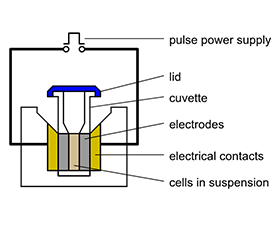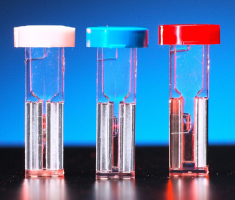In molecular biology, the electroporation process is commonly used for cell transfection/transformation, the non-viral DNA transfer, of bacteria, yeast, and plant protoplasts. Electroporation is also highly effective for the introduction of foreign genes in tissue culture cells, especially mammalian cells.
In laboratory practice, electroporation is done with an appliance that creates an electromagnetic field in the cell solution known as an electroporator. The cell suspension is pipetted into a glass or plastic cuvette which has two aluminum electrodes on its sides. Electroporation is used in many areas of molecular biology research as well as in the medical field. Some applications of electroporation include, DNA transfection or transformation, direct transfer of plasmids between cells, induced cell fusion, trans-dermal drug delivery, cancer tumor electrochemotherapy and gene therapy.
Benefits of electroporation- It is non-viral, non-toxic and can be used on all cell types including mammalian, bacteria, algae, plant and yeast.
- It can be used on cells in all forms, in vitro or in vivo/ex vivo.
- In vitro is Latin for “within glass” and includes suspension cell, tissue slice/whole organ, and adherent cell.
- In vivo/ex vivo Latin for “within the living” and includes tissue/whole organ, in ovo, and in utero.
- It’s not limited by plasmid size and uptake is immediate and requires no incubation.
- It’s reproducible, highly efficient and easy to use.
Electroporation Applications
- For gene/drug delivery, to study the effects of genes or drugs on cells.
- For research, medical, farming and manufacturing process.
- Vaccine Development
- To stimulate a more robust immune response.
- B-cell cloning, for monoclonal antibody production in mammalian cells
- Bacterial Libraries
What can be electroporated?
- Bacteria
- Fungi/Yeast
- Plants
- Others, insects, fish, mold, and amphibian
- Mammalian
- Primary explant culture
- Established cell lines
- Human, in vitro, in vivo, and ex vivo
Typical Transfectants
- DNA/RNA
- Antibodies/Proteins
- Drugs
- Other molecules/ions


Leave a Reply